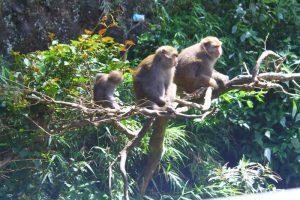(Excerpted from Eastern Taiwan by Eleven and Nine, originally run in Bicycle Times, Issue 17.)
Day Two: Over the mountains and into the rift
After breakfasting on a traditional Taiwanese quickie meal of danbing (a rolled up cheese omelet served with brown sauce and eaten with chopsticks) I continue south on route 11. In the town of Duli, I stop in front of the small police station, prompted by a sign that seems like a friendly suggestion: Bicyclist rest stop.
Officer Ma, a short, cheerful man, explains that his and three other stations along the coast have been designated as bicycle rest stops. and as such are equipped with air pumps, filtered water, and a grassy space out back where cyclists (or any traveler) can pitch a tent free of charge. There’s also a shower.

Just a few miles past Duli, I stop at Donghe Baozhi, a shop famous for its steamed buns. So well known is the bun shop that a satellite tourist industry has sprung up it. I browse trinkets, buy a coconut, and sit down to chat with a man surnamed Lin, who has ridden his steel-framed mountain bike the 40 kilometers from Taitung to buy a dozen of buns for his family.
“This is my Sunday ritual, weather permitting.” He tells me.

Saying goodbye to the coast, I head into across the mountains. My afternoon goal is Fuli, 30 kilometers away, where I plan to ride through great rift marking the place where the Asian and Pacific Plates meet. The Donghe Bridge is famous for its Monkey colony, and also marks the last flat stretch for hours. A steady, sometimes brutal and always beautiful climb awaits as route 23 climbs and climbs through the coastal mountains that lie between Taiwan’s coast and the Central Mountains. It’s mostly-uphill for 20K, with only the occasional dip (often heralded by sign) never long enough to be more than a tease.
Sea breezes now history, I stop on the top of a steep incline and eat the last of my Donghe veggie buns. The laws of physics, not to mention geology and geography, dictate that the road must head downhill at some point. I close in on what I hope is the final summit. Valleys filled with trees and fields spread all around. For nearly an hour I’ve seen nobody, and now, up ahead, a group of five men stand surrounding a sixth lying on the side of the road. Parked neatly end-to-end are several motorcycles, and I realize that this is the group of riders who’d passed me an hour ago at the 10K marker. The lying man is propped up on his elbows comfortably, as if watching television.
What a lovely idea. I think. I’d like to join him.
Pulling closer it dawns that something is amiss, lying on roadsides not a normal activity to men with motorcycles.
“Are you OK?” I ask the man on the ground.
“Except for the broken leg,”
He answers serenely, before explaining that he’d wiped out on a curve. I ask if he’s sure the leg is broken.
“Oh yes. It hurts terribly.”
I ask him if there’s anything I can do.
“Thanks, no. The ambulance should be here soon. My friends are watching for traffic.”
I bid the man farewell and continue riding, the road ahead stretching into a glorious downhill, one in which I’m more motivated than ever to take with extra care. Along the way I pass through small indigenous villages with rolling fields, fruit farms and unique folk art.
Another 6k of mostly-coasting brings me to Fuli, from where I catch Route 9. Running north to south on the rift side of the coastal mountain range, Route 9 runs roughly parallel to route 11.
Less winding than the coastal road, the Rift Road traverses a wide plain between mountain ranges containing a large swath of Taiwan’s prime fruit growing areas. I ride north, switching between the road (which has a wide bike lane) and a recently built bicycle-only path that’s been built over a discontinued railway line. The ride is easy, the air is fragrant and cool, and the scenery mostly fruit trees and rice paddies, dotted by a few small temples and the occasional roadside shrine. Along the way I pass dozens of local cyclists on everything ranging from ancient clunkers to state of the art racing bikes. Nearly all of the serious cyclists are wearing the cycling gear favored by the Taiwanese bike set – lycra shorts, long sleeves and cloth scarves that all but obscure their faces. I salute them as I pass, and find their attire strange. They wave back, and I can’t help but wonder what they think of my own cycling gear – camouflage shorts, a cut-off T-shirt, and many tattoos.
The final stretch of the day’s ride brings me through winding hills before flattening out at a hilltop tea shop surrounded by tea plantations. From here, it’s a beautiful coast into the town of Rueishiu, where my bed for the night at the Hoya Spa awaits. A lovely, family run hotel, my reason for returning to Hoya are its natural mineral baths, including a series of hot-spring gee-gaws featuring high pressure jets of many shapes and pointing in all directions.
As high velocity geothermic water hits the spots on my back where sun-block never quite made it, the wisdom behind the all-covering cycling fashion in this nation of tropical sun and hot-springs becomes clear.
Join us tomorrow for Day Two: Over the mountains and into the rift
Join me on Bicycle Adventures Autumn 2015 Taiwan Tour – it’s going to be epic! Mention this blog for your $100 discount!